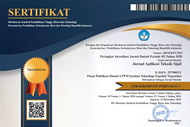Analisis Potensi Likuifaksi dan Perencanaan Perbaikan Tanah pada Bangunan Pemecah Gelombang di Wilayah Pantai Bali Selatan
Abstract
Keywords
Full Text:
PDFReferences
P. Hadiwidjojo, M. M. Samodra, and T. Amin, Peta Geologi Lembar Bali, Nusa Tenggara, Bandung. Pusat Penelitian dan Pengembangan Geologi, 1998.
H. B. Seed and I. M. Idriss, “Ground Motions and Soil Liquefaction during Earthquake. Earthquake Engineering Research Institute Monograph,” 1983.
T. L. Youd and I. M. Idriss, “Liquefaction Resistance of Soils: Summary Report from the 1996 NCEER and 1998 NCEER/NSF Workshops on Evaluation of Liquefaction Resistance of Soils,” J. Geotech. Geoenvironmental Eng., vol. 127, no. 4, 2001.
K. Tokimatsu and Y. Yoshimi, “Empirical Correlation of Soil Liquefaction Based on Spt N-Value and Fines Content.,” Soils Found., vol. 23, no. 4, 1983.
K. Kirsch and F. Kirsch, Ground Improvement by Deep Vibratory Methods. 2017.
E. Soebowo, “Geologi Teknik Sedimen Kuarter Dan Bahaya Amblesan, Likuifaksi Di Serangan – Tuban – Tanjung Benoa, Bali,” J. Ris. Geol. dan Pertamb., vol. 26, no. 1, 2016.
Darwis, Dasar-Dasar Teknik Perbaikan Tanah. 2017.
J. Han, Principle and Practice of Ground Improvement. 2015.
DOI: http://dx.doi.org/10.12962%2Fj2579-891X.v21i4.16440
Refbacks
- There are currently no refbacks.

Jurnal Aplikasi Teknik Sipil by Pusat Publikasi Ilmiah LPPM Institut Teknologi Sepuluh Nopember is licensed under a Creative Commons Attribution-ShareAlike 4.0 International License
Based on work at https://iptek.its.ac.id/index.php/jats




